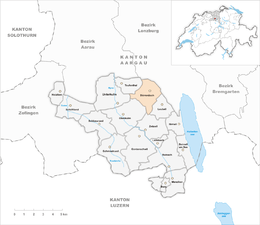Dürrenäsch
| Dürrenäsch | ||
|---|---|---|
 |
||
|
||
| Coordinates: 47°19′N 8°9′E / 47.317°N 8.150°ECoordinates: 47°19′N 8°9′E / 47.317°N 8.150°E | ||
| Country | Switzerland | |
| Canton | Aargau | |
| District | Kulm | |
| Area | ||
| • Total | 5.91 km2 (2.28 sq mi) | |
| Elevation | 562 m (1,844 ft) | |
| Population (Dec 2015) | ||
| • Total | 1,222 | |
| • Density | 210/km2 (540/sq mi) | |
| Postal code | 5724 | |
| SFOS number | 4134 | |
| Surrounded by | Hallwil, Leutwil, Oberkulm, Seon, Teufenthal, Unterkulm, Zetzwil | |
| Website |
www SFSO statistics |
|
Dürrenäsch is a municipality in the district of Kulm in the canton of Aargau in Switzerland.
While Dürrenäsch is first mentioned in 924 as Aske inferior, there are traces of earlier, nearby settlements. Several, individual Hallstatt era items were found on the castle hill. Roman era artifacts have been discovered on the Loren and Alamanni graves were found on the Lindhügel.
During the High Middle Ages Dürrenäsch was ruled by Lenzburg. In 1173 it came under the power of the Counts of Kyburg. A century later, in 1273, it was inherited by the Habsburgs. Under the Habsburgs it was ruled by their vassals, the Lords of Trostberg, Reinach and Hallwyl. From 1415 until 1798 it was under the control of the city of Bern and was part of the district (German: Oberamt) of Lenzburg. In 1433 Bern bought the rights to high and low justice, in the village, from the Austrians.
Until 1614 the village was part of the Kulm parish and since then it has belonged to the Leutwil parish.
Particularly tragic events were the big fire in the village in 1782 and in 1963, the crash of Swissair Flight 306 on the outskirts of Dürrenäsch (killing all 80 on board).
In addition to the still common agriculture industry, several other industries developed in the 18th-19th Centuries. Initially, cotton weaving and straw plaiting developed in the village. Then, between 1852-1935 the silk industry developed and between 1863 and 1950 the cigar industry was in the village. The Korkwarenfabrik (cork products factory) opened in 1878. Between 1952-54 it was rebuilt and went into production of new types of insulation and plastics as the Sagex factory.
...
Wikipedia




